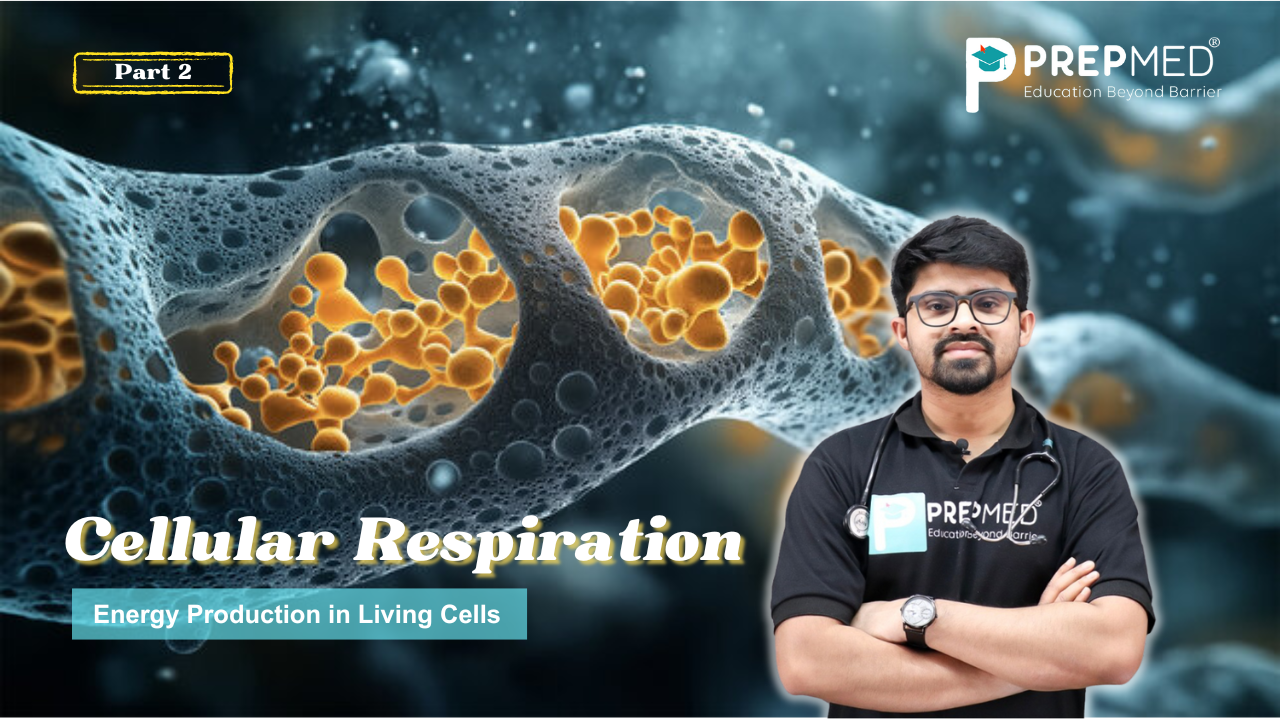January 13, 2025
Cellular Respiration: Energy Production in Living Cells PART 2
The Krebs cycle, sometimes called the TCA cycle – tricarboxylic acid cycle – or Citric acid cycle occurs in the mitochondrial matrix and is an important series of enzyme-catalysed reactions. In this cycle, acetyl-CoA is oxidised to give out CO2 while coenzymes are reduced to supply ATP through the electron transport chain.
The Krebs cycle is named after Hans Krebs, who suggested the detailed working of the cycle. It consists of eight steps. In this step, the acetyl group of acetyl-CoA is oxidized into two carbon dioxide molecules and single ATP molecule. Also, the process generates other essential high-energy compounds such as NADH and FADH2.
Although each glucose molecule generates 2 molecules of acetyl-CoA, two turns through the Krebs cycle are required. This results in the synthesis of 4 CO2 molecules, 6 NADH molecules, 2 FADH2 molecules, and 2 ATP molecules.
- The TCA cycle begins at the formation of citrate from the condensation of an acetyl group with oxaloacetate, and water. This is done through a process catalysed by the enzyme called citrate synthase and in this process a CoA molecule is also produced.
- Citrate is then converted to isocitrate. This is succeeded by the two sequential processes of decarboxylation, which result from information of α-ketoglutaric acid and succinyl-CoA, respectively.
- In the remaining steps of the citric acid cycle, succinyl-CoA is oxidised to OAA making the cycle continue. Succinyl-CoA is transformed to succinic acid in the process, and a molecule of GTP is generated in the process.
- This is a substrate level phosphorylation. In a coupled reaction GTP is converted to GDP and at the same time ATP is synthesized from ADP.
- Also during the cycle there are three situations where NAD+ is converted to NADH + H+ and one situation where FAD+ is reduced to FADH2. The sequential oxidation of acetyl CoA in the TCA cycle mandates the constant regeneration of the first compound in the cycle, that is oxaloacetic acid. However, it also involves regeneration of NAD+ from NADH and FAD+ from FADH2.
- Perhaps the simplest overall equation for this phase of respiration can be summarized in the following manner:
EQUATION: Pyruvic acid + 4 NAD++FAD++2H2O+ADP+Pi → 3CO2+4 NADH+4H++FADH2+ATP
Electron Transport System (ETS) and Oxidative Phosphorylation
Let's compare Electron Transport System (ETS) and Oxidative Phosphorylation. These are two events taking place in cellular respiration in most of the Eukaryotic mitochondria and prokaryotic plasma membrane. This is important in the production of ATP, which is the cell’s basic unit of energy, through electron transport involving complexes of proteins that use the energy from the transport of protons across the membrane. This generates a proton gradient which is then used to generate ATP via oxidative phosphorylation. Thus, ETS and oxidative phosphorylation generate the energy required in the diverse processes of the cell and are crucial to the aerobic process.
The sequence of systems through which the electron is transferred to the next transporter is called the electron transport chain or ETC for short. The ETC complex is embedded on the inner mitochondrial membrane of eukaryotic cells, and plasma membrane of prokaryotic cells. The main components of the ETC is:
- Complex I (NADH dehydrogenase)
- Complex II (Succinate dehydrogenase)
- Complex III (Cytochrome bc₁ complex)
- Cytochrome c
- Complex IV (Cytochrome oxidase)
- Complex V (ATP synthase)
NADH2 is oxidized by NADH dehydrogenase along with transferring the electrons to ubiquinone embedded within the inner mitochondrial membrane. In complex II, which is succinate dehydrogenase, FADH2 is oxidized and transferred electrons to ubiquinone. The decreased ubiquinone is then oxidized with the move of electrons by the help of cytochrome bc 1 complex to cytochrome c.
Cytochrome C is a small protein attached to the external surface of the internal film and moves electrons from complex III to complex IV. When the electrons transferred first from one carrier to next by way of complex I to complex IV, they are coupled to ATP synthesis of ATP from ADP and Pi (inorganic phosphate) Oxygen plays crucial role in removing electrons and hydrogen particles and finally helps in formation of H₂.
Oxidative Phosphorylation
Oxidative phosphorylation is the terminal oxidation of high impact on breath. This is the cycle where ATP is constructed using the help of electron transfer from the electron transport chain. The F1 molecule is the place where oxidative phosphorylation occurs. It comprises an ATP synthase catalyst. When proton convergence is bigger at the F0 region than in the F1 molecule, ATP synthase becomes dynamic for ATP synthesis. The energy from the proton slope is used to attach the phosphate radical and ADP by high energy bond to form ATP.
Describe the process of Oxidative Phosphorylation
Electron Transport Chain (ETC): The process is initiated by the electron transport chain, a series of complexes placed on the interior face of the mitochondria. In the process of cellular respiration NADH and FADH2 give their electrons to the electron transport chain.
Proton Pumping: As electrons pass in the electron transport chain, these electrons release energy that is used as energy to transport protons (H+) across the inner mitochondrial membrane to create an electrochemical gradient.
ATP Synthase: The electrochemical gradient produced by the process of pumping protons across to the mitochondrial membrane causes the protons to flow back through the protein complex called ATP synthase. These protons then flow back into the membrane through the ATP synthase and through this is utilise to synthesize ATP from adenosine diphosphate (ADP) and inorganic phosphate (Pi) in a process referred to as phosphorylation.
Formation of ATP: This process is known as oxidative phosphorylation and leads to the synthesis of ATP, which is the most important energy rich compound in the cell. For each molecule of NADH entering the ETC, it is estimated that between 2.5 – 3 ATP molecules are produced for each molecule of FADH2, the physiological yield ranges between 1.5 – 2 ATP molecules.
In conclusion: Electron Transport System (ETS) and Oxidative Phosphorylation are complex processes that play a major role in the process of cellular respiration in the mitochondria of a eukaryotic cell as well as in a prokaryotic cell membrane. These processes are crucial in ATP production this occurs through the transfer of electrons through protein complexes and generation of a proton gradient to power the ATP synthesis. ETS and Oxidative phosphorylation jointly provide energy for various cellular activities and therefore form basic components of aerobic metabolism.
Describe Respiratory Quotient
Amount of carbon dioxide produced in respiration compared with the volume of oxygen used is called the Respiratory quotient (RQ) or respiratory ratio. The respiratory quotient is therefore determined by the type of respiratory substrate employed during respiration.
- If the substrate used is carbohydrate and is fully oxidized the general value of RQ will be 1 since both CO2 and O2 are produced and consumed in a proportionate ratio.
- If fats are used up for respiration, the RQ is less than 1.
- If the proteins are respiratory substrates the ratio would be nearer about 0.9.
FAQS:
- How does the process of respiration differ between aerobic and anaerobic conditions in the plant?
While aerobic respiration takes place in the presence of oxygen, it yields more ATPs and releases carbon dioxide as an outcome.
Anaerobic respiration occurs without the use of oxygen and gives comparatively low amount of energy along with some products such as ethanol in plants (sometimes), carbon dioxide, etc.
- In plants, respiration takes place in which cellular organelle?
In plant cells, respiration takes place in the cytoplasm during the glycolysis step and in mitochondria during the Krebs cycle and the electron transport process.
- What is the role of glycolysis in plant respiration?
Glycolysis is the first aspect of cellular respiration and takes place in the cytoplasm of the cell. During this process one molecule of glucose, a 6-carbon compound undergoes oxidative decarboxylation and is converted into 2 molecules of pyruvate, a 3-carbon compound generating a tiny amount of ATP and NADH.






